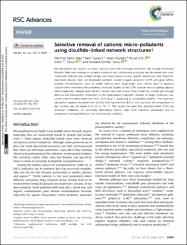| dc.contributor.author | Atas, Mehmet Sahin | |
| dc.contributor.author | Dursun, Sami | |
| dc.contributor.author | Akyildiz, Hasan | |
| dc.contributor.author | Citir, Murat | |
| dc.contributor.author | Yavuz, Cafer T. | |
| dc.contributor.author | Yavuz, Mustafa Selman | |
| dc.date.accessioned | 2020-02-14T08:56:24Z | |
| dc.date.available | 2020-02-14T08:56:24Z | |
| dc.date.issued | 207-05-15 | en_US |
| dc.identifier.issn | 2046-2069 | |
| dc.identifier.other | DOI: 10.1039/c7ra04775d | |
| dc.identifier.uri | https://hdl.handle.net/20.500.12573/157 | |
| dc.description | This study was carried out as a Master thesis by Mehmet Sahin Atas at the Graduate School of Natural and Applied Science at Selcuk University, Konya, Turkey. Support for this work is provided by the Scientific Research Foundation (BAP) of Selcuk University, Scientific and Technological Research Council of Turkey (TUBITAK MAG) (Project Number 214M232) and Academic Staff Training Program (OYP) (Project Number 2015-OYP-128), which authors gratefully acknowledge. C. T. Y. thanks for the support from National Research Foundation (NRF) of Korea, No: NRF-2016R1A2B4011027. | en_US |
| dc.description.abstract | Micropollutants are found in all water sources, even after thorough treatments that include membrane filtration. New ones emerge as complex molecules are continuously produced and discarded after used. Treatment methods and sorbent designs are mainly based on non-specific interactions and, therefore, have been elusive. Here, we developed swellable covalent organic polymers (COP) with great affinity towards micropollutants, such as textile industry dyes. Surprisingly, only cationic dyes in aqueous solution were selectively and completely removed. Studies of the COPs surfaces led to a gating capture, where negatively charged layer attracts cationic dyes and moves them inside the swollen gel through diffusive and hydrophobic interaction of the hydrocarbon fragments. Despite its larger molecular size, crystal violet has been taken the most, 13.4 mg g(-1), surpassing all competing sorbents. The maximum adsorption capacity increased from 12.4 to 14.6 mg and from 8.9 to 11.4 mg when the temperature of dye solution was increased from 20 to 70 degrees C. The results indicated that disulfide-linked COPs are attractive candidates for selectively eliminating cationic dyes from industrial wastewater due to exceptional swelling behaviour, low-cost and easy synthesis. | en_US |
| dc.description.sponsorship | Selcuk University Turkiye Bilimsel ve Teknolojik Arastirma Kurumu (TUBITAK) 214M232 Ministry of National Education - Turkey 2015-OYP-128 National Research Foundation of Korea NRF-2016R1A2B4011027 | en_US |
| dc.language.iso | eng | en_US |
| dc.publisher | ROYAL SOC CHEMISTRY, THOMAS GRAHAM HOUSE, SCIENCE PARK, MILTON RD, CAMBRIDGE CB4 0WF, CAMBS, ENGLAND | en_US |
| dc.relation.ispartofseries | Volume: 7 Issue: 42 Pages: 25969-25977; | |
| dc.rights | info:eu-repo/semantics/openAccess | en_US |
| dc.subject | HIERARCHICAL POROUS FRAMEWORKS | en_US |
| dc.subject | COVALENT ORGANIC POLYMERS | en_US |
| dc.subject | CARBON-DIOXIDE ADSORPTION | en_US |
| dc.subject | SENSITIZED SOLAR-CELLS | en_US |
| dc.subject | LOW-COST ADSORBENTS | en_US |
| dc.subject | AQUEOUS-SOLUTION; | en_US |
| dc.subject | METHYLENE-BLUE | en_US |
| dc.subject | DYE REMOVAL | en_US |
| dc.title | Selective removal of cationic micro-pollutants using disulfide-linked network structures | en_US |
| dc.type | article | en_US |
| dc.contributor.department | AGÜ, Mühendislik Fakültesi, Malzeme Bilimi ve Nanoteknoloji Mühendisliği Bölümü | en_US |
| dc.contributor.institutionauthor | | |
| dc.identifier.doi | 10.1039/c7ra04775d | |
| dc.relation.publicationcategory | Makale - Uluslararası Hakemli Dergi - Kurum Öğretim Elemanı | en_US |


















